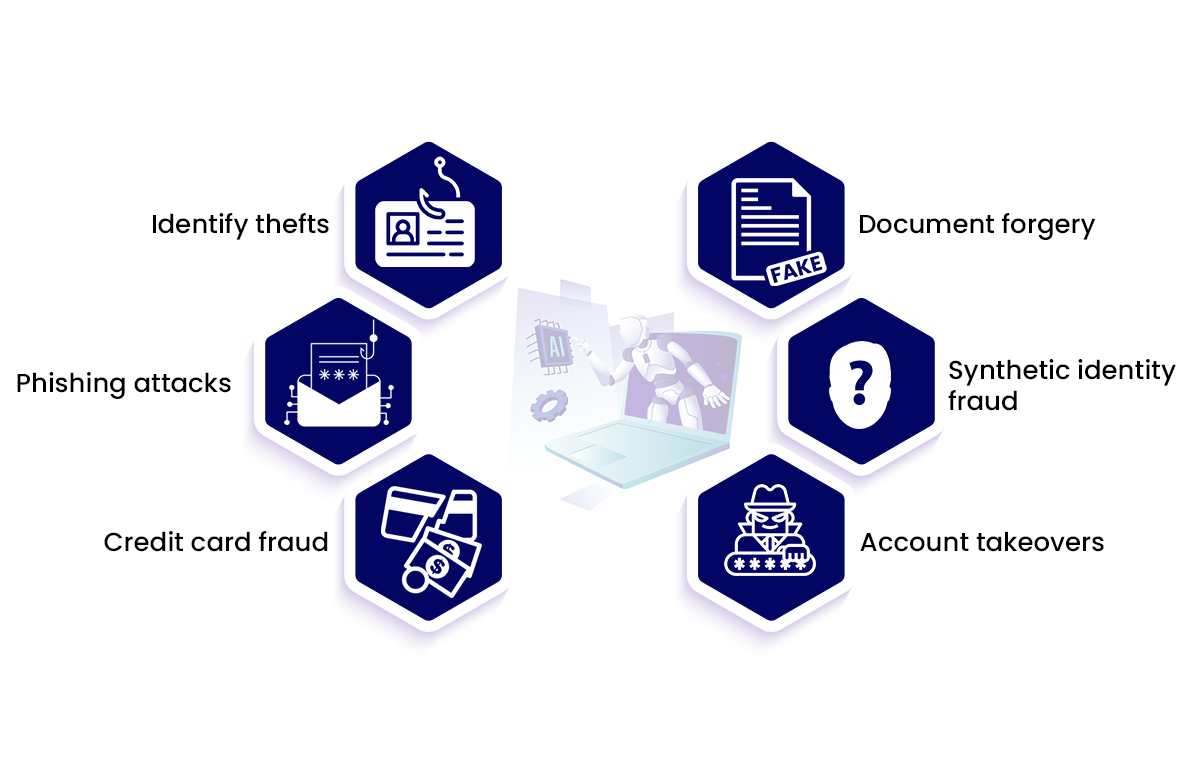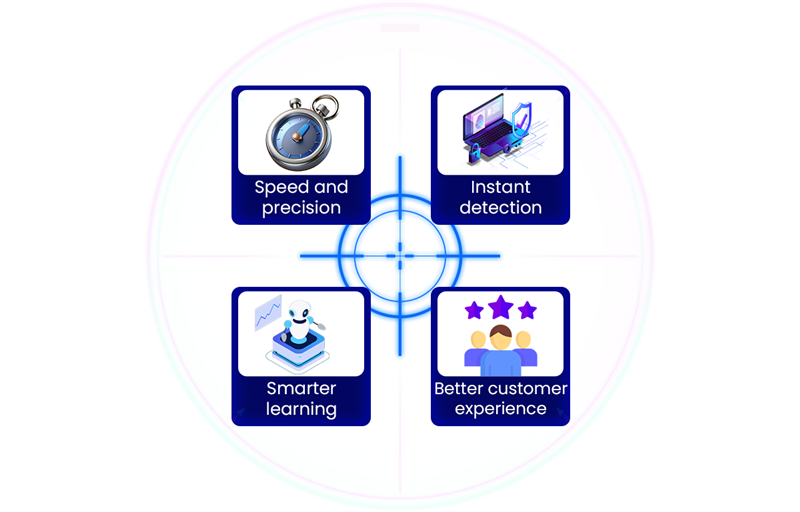As the online transactions keep on increasing because of the convenience and speed, it not only brings the smarter solution but also opens the path for more frequent fraud. The old or traditional fraud detection methods often become the victims of new types of fraud because it becomes difficult for them to quickly spot the tricky fraud patterns and unusual behavior.
However, by incorporating AI into banking and financial services, institutions can identify unusual or tricky fraudulent patterns, allowing them to quickly minimize false alarms and detect fraud in real time. But in reality, AI is not as simple as just flipping the switch because it needs more strong tech-enabled systems and clean data along with thoughtful planning to handle the ethical issues.
If a financial institution is uncertain about how AI can deliver real value and help them avoid costly mistakes, then AI consulting services are one of the best go-to options available.
This blog aims to share practical insights regarding how to utilize AI in financial institutions to avoid fraud in an effective way and how they can build practical and powerful AI systems.
Key Market Statistics of AI in Banking and Financial Sector
1. In 2023, the global financial system experienced $3.1 trillion in illegal money flows. During that period, experts projected that fraud and banking scams would cost nearly $486 billion in losses worldwide. This figure highlights the critical need for financial institutions to adopt advanced fraud detection and risk management strategies.
2. In financial fraud and compliance management, the integration of AI is driving significant market growth. Valued at $13.05 billion in 2024, the market is projected to reach $15.64 billion in 2025, reflecting a CAGR of 19.8%. This surge is attributed to rising cyber threats, increased transaction volumes, and frequent data breaches.
3. With AI playing a pivotal role in fraud management, businesses are increasingly investing in AI technologies to establish a safe and secure ecosystem for providers and consultants alike.
Discover How We’re Powering Innovation with AI
See how Zenesys is helping businesses solve complex problems and build smarter systems using Artificial Intelligence. Dive into our real-world AI solutions and success stories.
Explore Our AI WorkWell, what is exactly AI in Fraud Detection?
AI fraud detection utilizes artificial intelligence and machine learning to identify warning signs of fraud, including suspicious patterns, unusual spending, strange logins, device activity, and more. As the traditional systems highly rely on the fixed protocols, AI learns from all the data points that have been incorporated in the whole data cycle. It helps in evolving itself over a regular span and detect fraudulent patterns more accurately.
The systems typically operate in real time and assist in analyzing large volumes of data based on user behavior and activity, including how users interact with various devices and which device they are using to log in. With the growing reliance on cloud computing hosting, AI-powered solutions can scale efficiently, ensuring that even businesses handling massive amounts of user data are protected with advanced fraud detection capabilities.
Analyzing all user behavior and patterns helps to stop fraud before it actually takes place. As the fraudsters are also getting more evolved and keep on utilizing different AI tools and strategies, it is highly beneficial for businesses and financial banks to become more adaptive and get themselves ready to stay ahead so that they can avoid those fraudulent and suspicious activities.
Head-to-Head Comparison: Traditional System Vs. AI in Fraud Detection
| Key Parameter | Traditional Fraud Detection | AI in Fraud Detection |
|---|---|---|
| Detection method | It utilizes predefined rule-based logic, which is generally static in nature, such as transaction limits and blacklists. | It uses real-time and dynamic algorithms that can effectively adapt based on current and historical data. |
| Real-time monitoring | It usually gives a red flag once the transaction has been completed, which is often delayed or reactive in nature. | It ensures that the fraud detection is being enabled in real time or close to real time and sends alerts accordingly. |
| New threats adaptability | It is solely dependent on manual updates, so this system evolves with the fraud tactics. | It keeps on learning and adapting to new threats by recognizing and incorporating new patterns and behaviors and updating itself. |
| False positive | It usually red flags the conditions that are not even the ones because of the fixed protocols, which lead to unnecessary reviews and customer friction. | It reduces false alarms by accessing user behavior, regular patterns and their context. |
| Operational load | It heavily relies on compliance teams along with manual investigation. | It usually minimizes the load of analysts because it automates the investigation procedure. |
| Fraud type coverage | It works great in repeated fraud scenarios and with the ones who are already known. | It is well versed in detecting sophisticated, new, and known fraud schemes, such as identity theft or account takeover, etc. |
| Response time | As there is a manual verification, it takes more time. | Instant alerts allow instant action, and they prevent losses to a great extent. |
What kinds of fraud are determined using AI in the Financial Industry?

-
Identify thefts
AI has the capability to spot the unusual changes when they happen in the customer behavior, such as contact updates or sudden password changes. It will give the red flag instantly and enhance the additional security check so that they can avoid unauthorized access. -
Phishing attacks
By utilizing the patterns and email contacts, AI has a huge potential to suspect the messages so that it can prevent users from going into financial scams. -
Credit card fraud
AI monitors the spending habit of a user in real time; if any transaction that looks awkward or unusual occurs, then it can alert the customer or halt the payment before the damage happens. -
Document forgery
AI has incredible tools that can compare the documents and find out the fake documents so that it can ensure that the account and loan application are actually requested by the real user, not a fraudster. -
Synthetic identity fraud
AI comprises smart tools that can double-check the customer data via the magnitude of the system so that it can detect the fake profiles that are being created with the help of fake and real information. For financial institutions looking to streamline lending processes, a list of loan origination systems can help identify the right software to manage applications efficiently and reduce risk -
Account takeovers
AI responds in a quick manner when it notices sudden changes in the login behavior, such as a new device transaction or location type; it can lock down the accounts so that it can protect the user from fraud.
What are the incredible benefits of using AI in the financial sector?

-
Speed and precision
AI massively handles the large chunk of data incredibly and is capable of catching irregularities in a more accurate manner in comparison with the traditional methods. This way, it allows the transaction verification to be faster and provides better insights to the team so they can take appropriate action.
-
Instant detection
Whenever any unusual activity, such as suspicious logins or transactions happens, it can respond right away without delay. In this way it can minimize the damage that can happen. -
Smarter learning
As it does not follow any fixed rule pattern, it improvises on a regular basis. It can effectively study the historical or past data, and machine learning adjusts to the new fraud techniques without needing any constant human updates. -
Better customer experience
AI effectively minimizes the false alarms so that it provides a better customer experience, as the genuine customers’ accounts don't get blocked inappropriately. In this way, it helps the financial sector to gain users’ trust.
The case studies of top financial institutions using AI in fraud detection
AI aids in identifying fraud and offers valuable strategies to assist financial sectors in managing it. Here are some real cases demonstrating how financial institutions utilize AI to prevent fraudulent activities.

- MasterCard
- MasterCard incorporates the advanced and comprehensive AI tools that analyze the transactions before the money is actually being transferred.
- Their system assigns risk scores to accounts based on past consumer activities and real-time data analysis.
- It effectively assesses the behavior of how the payment network works along with finding out the potential threats on an early basis.
- This technology efficiently helps in preventing pre-frauds and reaches the user's account.
- Stripe
- Stripe has come up with a smart real-time fraud detection tool, which is created based on getting training from millions of business data.
- By incorporating machine learning tactics, this system, known as Radar, can detect suspicious activity.
- It keeps on adapting to the real-time scenarios by fetching the data to find out new fraud patterns that have been happening across global payment flows.
- After their Radar system deployment, Stripe saw a significant drop, which is around 80%, when it comes to their card testing fraud.
- Businesses can also incorporate fraud rules depending upon the risk level and the industry they have.
- Swedbank
- It effectively incorporates next-generation AI so that they can avoid complicated frauds.
- They have implemented the modernized AI practices, which significantly depend on Generative Adversarial Networks, which are referred to as GANs.
- These models help in uncovering the unusual behavior and find out the patterns that have been missed by the traditional systems.
- American Express
- American Express has improved their fraud detection accuracy by incorporating the highly effective AI model system.
- They are capable of meeting the demands of rising security and are also adaptive because of their deep learning technique, which can optimize precision and improvise decision-making.
- It can deploy the deep learning AI models with the help of NVIDIA TensorRT.
- It also deployed
Community Discussion: How Will AI Transform the Financial Industry in the Long Run?
How do you see AI transforming the financial industry long term?
by u/FairShotFinance in ArtificialInteligence
Accelerate AI in fraud prevention and detection with Zenesys
AI in fraud detection has significantly improved accuracy by minimizing false positives and helping the financial sector adapt to the latest fraud tactics. Zenesys AI Consulting Services helps you in implementing the strategic AI fraud prevention and detection practices and framework, which support finding out the emerging fraud tactics and fraudulent transactions before the funds leave the user account, along with analyzing the transaction patterns in real time to make the fraud interception rate better.
FAQs
1. How do banks utilize artificial intelligence in fraud detection?
Financial sectors integrate AI to analyze, monitor and track the frauds at various touch points so that they can prevent them. AI tools spot unusual activities such as unexpected card use, login attempts, and real-time account activity and flag high-risk customer behavior instantly. AI also helps in identifying the fake patterns when it comes to loan applications; it also strengthens the anti-money laundering checks and KYC.
2. What are the core benefits of utilizing AI in financial industries?
AI has been changing the way the financial sector works by providing them faster and smarter ways to detect and prevent fraud and protect the customers money. The major benefits incorporated are:
- Preventing fraud before it occurs is one of the main benefits of AI.
- Real-time monitoring of account behavior and transactions.
- Fewer false positives ensure that genuine customer accounts are not blocked.
- Reduce the operational cost by converting the manual review tasks into automation.
- Better compliance with KYC and anti-money laundering rules, along with offering seamless experiences, builds strong customer trust.
3. Is AI-based fraud detection an expensive investment?
When it comes to setting up the AI-based fraud detection mechanism, that usually comes with some upfront cost, but in the long run the return on investment is much higher. The main reason it is lucrative is that it helps the financial systems to prevent fraud before it actually happens, lowers operational expenses, and ensures strict compliance with financial regulations.


.webp?lang=en-US&ext=.webp)

.webp?lang=en-US&ext=.webp)

